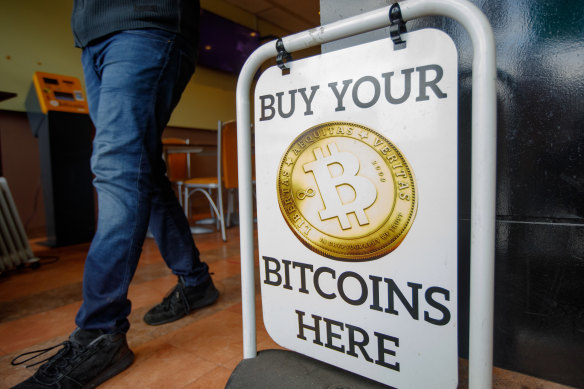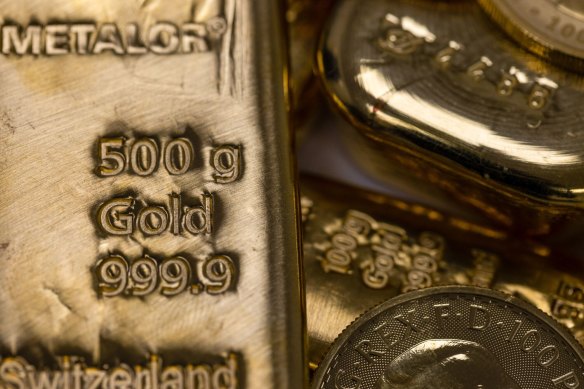‘I want to take risks while I can’: What young investors are betting on
As international investors try to read the tea leaves on how deeply the US central bank will cut interest rates, two investment options have been on the rise before this week’s widely expected loosening in monetary policy.
The values of gold and cryptocurrency have been surging. The former reached an all-time high of more than $US2500 an ounce this month and bitcoin is up 33 per cent year to date at around $86,500.

Bitcoin, sometimes referred to as “digital gold”, has risen by a third this year.Credit: Bloomberg
Both commodities share similarities. Neither gold nor bitcoin are used to buy things in shops, so they are impractical for everyday use. Both are also mined; one in the traditional sense, and the other virtually. Importantly, both are also viewed by some investors as a store of value that is not directly linked to the price of shares or bonds – though whether bitcoin really is “uncorrelated” is debated.
So with gold and bitcoin both in rude health, which one are young Australians picking up?
Investor James Giardinazzo, 26, said the bitcoin buzz tended to attract young people like himself.
“I won’t lie, the initial attraction was definitely the life-changing gains and the potential shot to be one of the people that gets lucky with a needle in a haystack and make potentially life-changing money in a few months,” Giardinazzo said.
But he said once the initial shine had worn off, his ongoing research into the cryptocurrency market – specifically, bitcoin – and why investors and traders considered it valuable, kept his interest.
“I definitely don’t have any type of aversion to trad-fi [traditional finance]; it’s just that I’m only in my 20s once, and I want to take risks while I can.”
He said he hoped to one day expand his portfolio, including into gold or index funds, but those investments did not meet his current needs or interests.
“[Those investments have] almost turned into a luxury for people with an already established portfolio looking to diversify and hedge against their more risky investments,” he said.
AMP deputy chief economist Diana Mousina said Gen Z – adults aged 27 and under – had about 30 per cent of their investments, excluding superannuation and the family home, in cryptocurrency.
“[Whereas] a Baby Boomer has 1 to 2 per cent invested in crypto on average. So you can see big divergences in people’s investment philosophies,” she said.
Mousina said cryptocurrency was a volatile asset class, and older generations tended to prefer more secure investments, while internet forums had popularised non-traditional investments such as cryptocurrency for younger groups.
“Things like crypto are seen as unique and cool by the younger cohorts,” she said.
“It has had some pretty good returns throughout time, even if it’s short-lived. So people get excited by the fact that they might be able to make a good return on it.”

Gold prices are at record highs.Credit: Bloomberg
She said it was difficult to determine what drove the value of cryptocurrency, and that it had not performed like an alternative asset class as many had initially predicted.
“There is no fundamental analysis that you can do on it, which is why it’s so hard to understand and predict what’s going to happen to the price. It hasn’t really performed that inverse relationship to other asset classes.”
She said the price of gold, in comparison, was driven up by recession fears and the threat of global war, as well as the commodity being used as a hedge against inflation.
Mousina said the physicality of purchasing the asset had also traditionally attracted conservative investors, though recently, its value as an alternative investment was what was most appealing.
As well as being seen as a haven asset in times of uncertainty, gold can be more attractive to investors when interest rates are falling. European interest rates were cut last week, and the US Federal Reserve is expected to cut rates this Thursday. Cryptocurrencies such as bitcoin are regarded as riskier assets, which can also benefit from rate cuts.
Data from financial comparison platform Finder showed more than one in four Australians have owned, or are interested in owning, cryptocurrency. Gen Z were the generation most likely to say they had traded cryptocurrency in the past 12 months, followed by Millennials, according to the Consumer Cryptocurrency Report 2024.
Finder head of consumer research Graham Cooke said interest in gold remained relatively stable, despite cryptocurrency appealing more to young investors.
“There has been a noticeable increase in crypto adoption since around 2017, peaking during the 2021 bull market. However, it has faced some volatility, with 2022 seeing a downturn due to major market corrections and a significant drop in August 2024 from which bitcoin has yet to fully recover,” he said.
The Business Briefing newsletter delivers major stories, exclusive coverage and expert opinion. Sign up to get it every weekday morning.